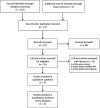Diagnostic significance of circulating miRNAs in Kawasaki disease in China: Current evidence based on a meta-analysis
- PMID: 33578520
- PMCID: PMC7886432
- DOI: 10.1097/MD.0000000000024174
Diagnostic significance of circulating miRNAs in Kawasaki disease in China: Current evidence based on a meta-analysis
Abstract
Background: There is no golden standard for the diagnosis of Kawasaki disease (KD), the most common cause of acquired heart disease in children in many countries. In recent years, many studies have focused on the relationship between microRNAs (miRNAs) and KD. Thus, we perform this meta-analysis to understand the role of circulating miRNAs as a biomarker to detect KD.
Methods: We searched PubMed, EMBASE, the Cochrane Central Register of Controlled Trials, and China National Knowledge Infrastructure through March 10, 2019. Meta-disc 1.4 and STATA 15.1 (Stata Corporation, College Station, TX) were used to conduct the meta-analysis.
Results: Six eligible articles were included in this meta-analysis. The overall performance of total mixed miRNAs detection was: pooled sensitivity, 0.7 (95% confidence interval, 0.66-0.74); pooled specificity, 0.87 (95% confidence interval, 0.83-0.90); and area under the summary receiver operating characteristic curves value (SROC), 0.8302. The meta-regression analysis indicated that the specimen types, the composition of the control group, and types of the reference miRNA were not responsible for the existing heterogeneities. The subgroup analysis showed that SROC of the plasma group (0.8890) was more significant than the serum group (0.7204), and SROC of the non-healthy control group (0.9622) was more significant than the healthy control group (0.8096).
Conclusions: : This is the first meta-analysis show that miRNAs may be used as novel biomarkers for detecting KD, especially for distinguishing KD from other febrile diseases. More studies are needed in the future to clarify the association between KD and miRNAs.
Prospero registration number: CRD42019129976.
Copyright © 2021 the Author(s). Published by Wolters Kluwer Health, Inc.
Conflict of interest statement
The authors have no conflicts of interest to disclose.
Figures





References
-
- Newburger JW, Takahashi M, Gerber MA, et al. Diagnosis, treatment, and long-term management of Kawasaki disease: a statement for health professionals from the committee on rheumatic fever, endocarditis and kawasaki disease, council on cardiovascular disease in the young, American Heart Association. Circulation 2004;110:2747–71. - PubMed
-
- Singh S, Vignesh P, Burgner D. The epidemiology of Kawasaki disease: a global update. Arch Dis Child 2015;100:1084–8. - PubMed
-
- Singh S, Bhattad S, Gupta A, et al. Mortality in children with Kawasaki disease: 20 years of experience from a tertiary care centre in North India. Clin Exp Rheumatol 2016;34:S129–33. - PubMed
-
- Takahashi K, Oharaseki T, Yokouchi Y. Histopathological aspects of cardiovascular lesions in Kawasaki disease. Int J Rheum Dis 2018;21:31–5. - PubMed
Publication types
MeSH terms
Substances
Grants and funding
LinkOut - more resources
Full Text Sources
Other Literature Sources
Medical

